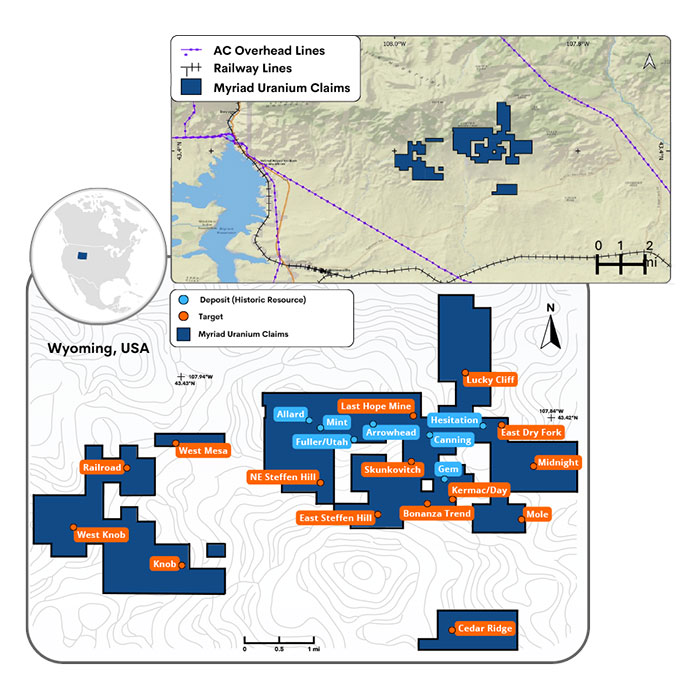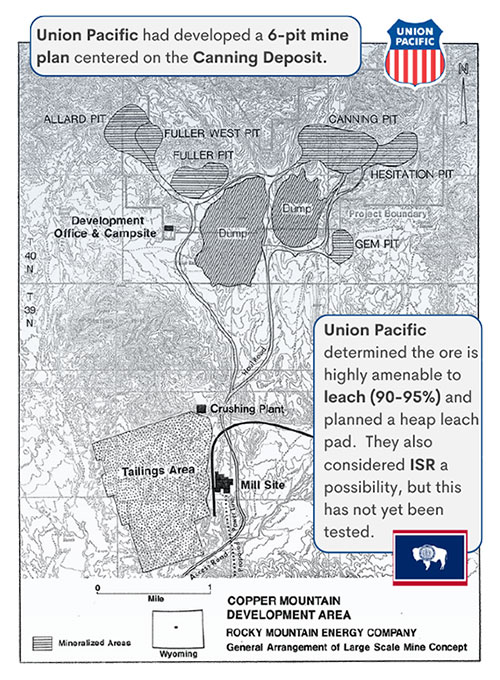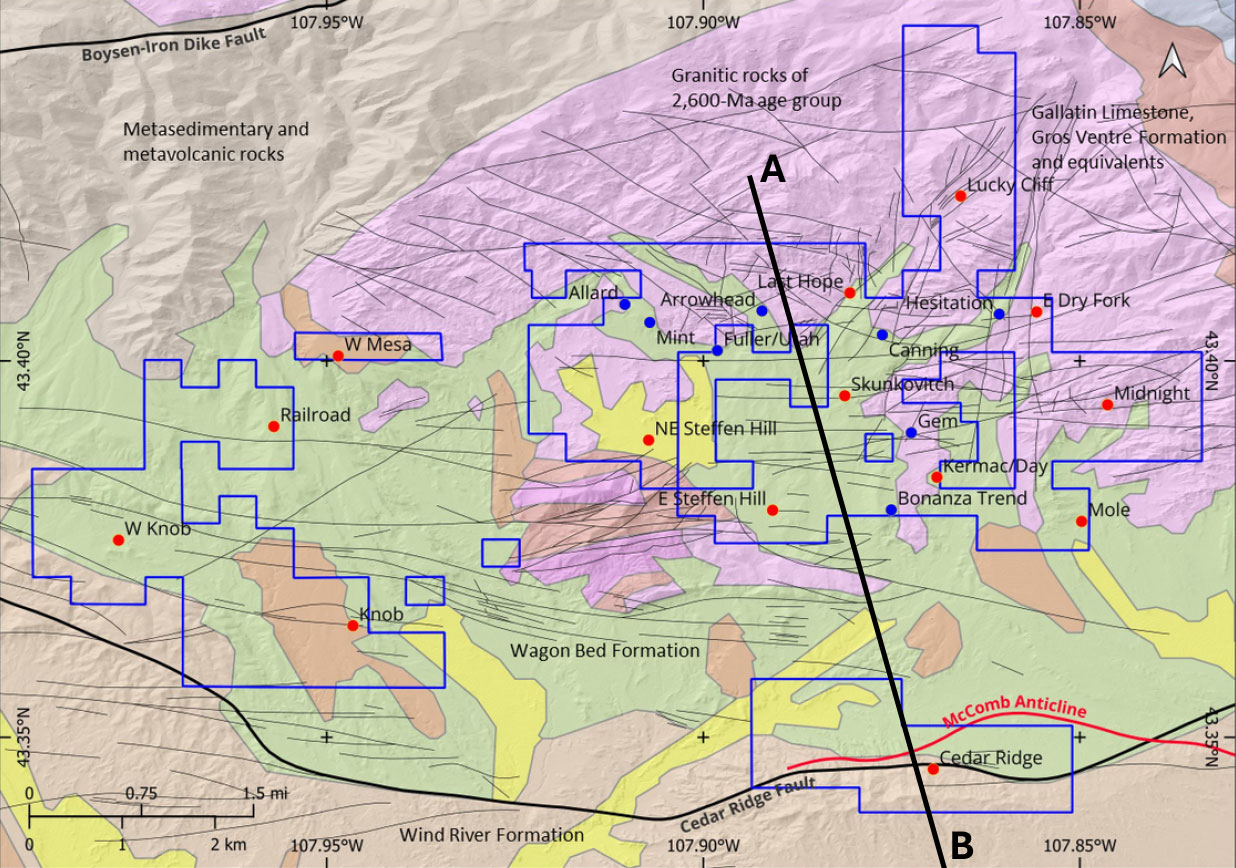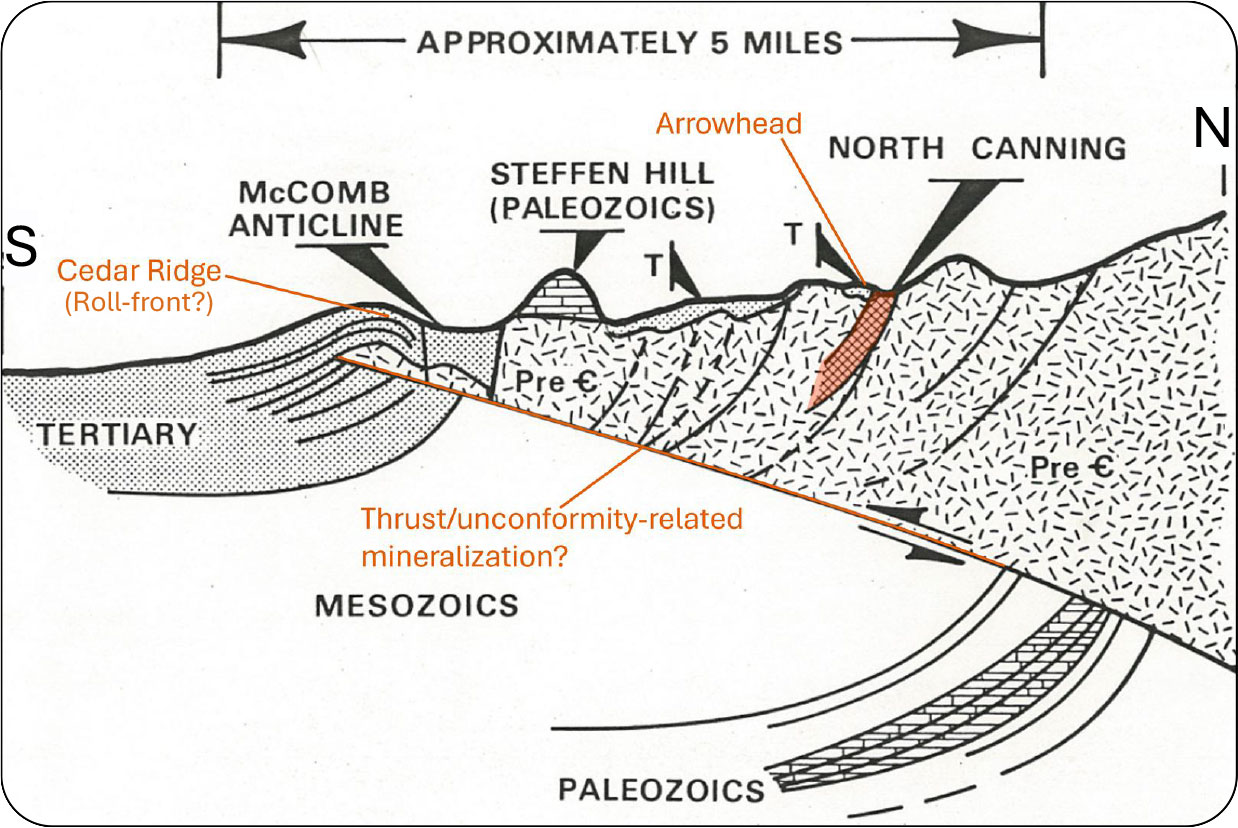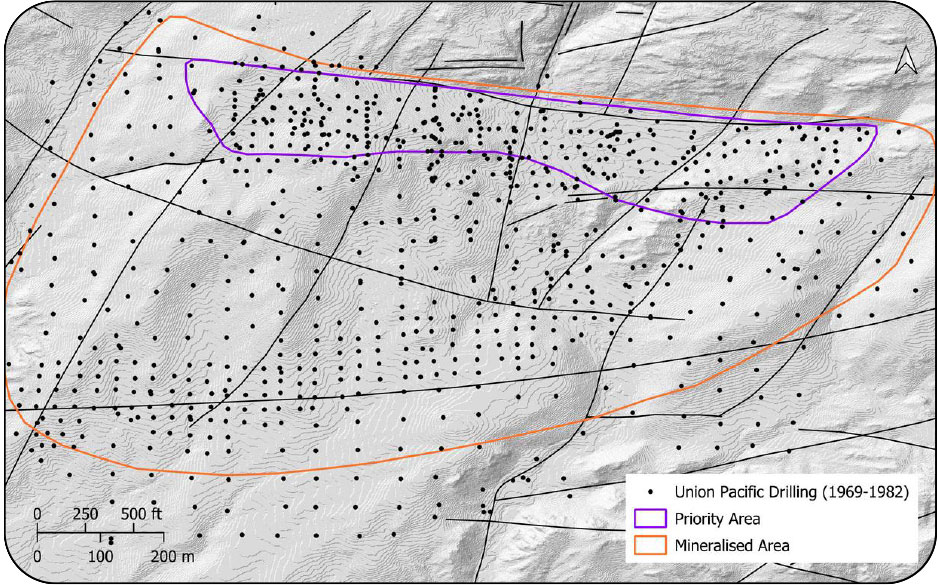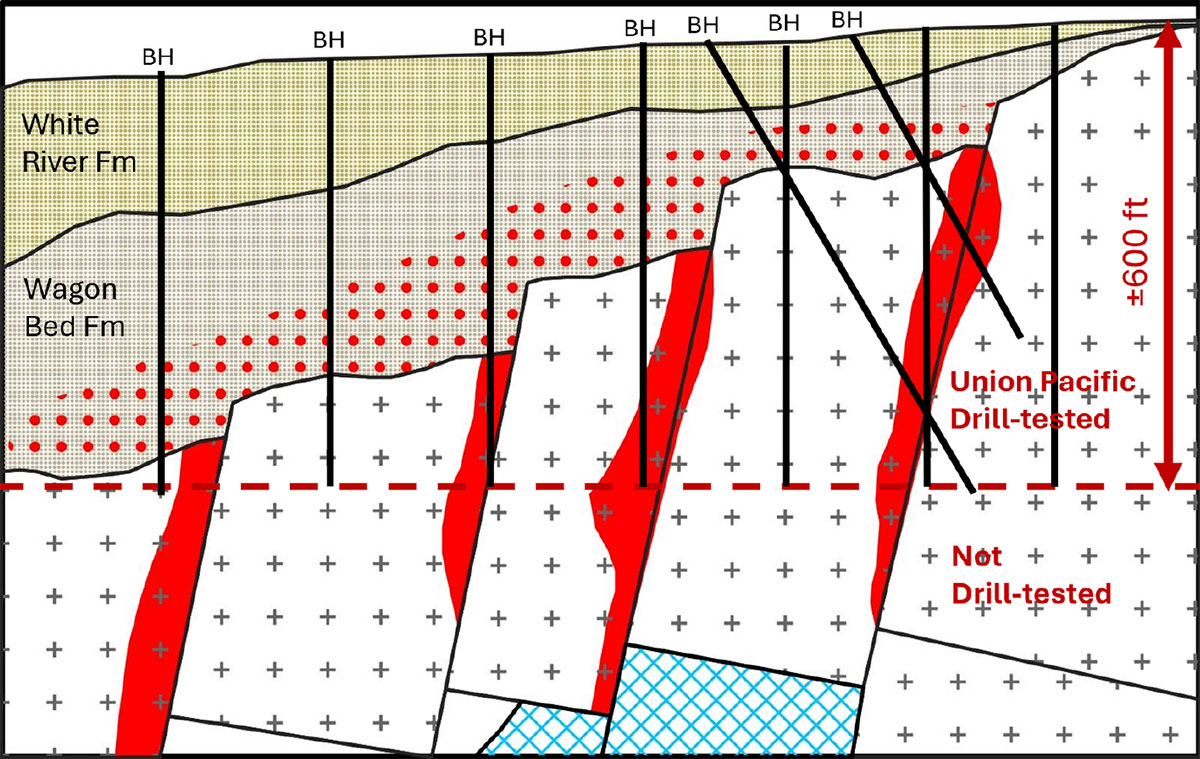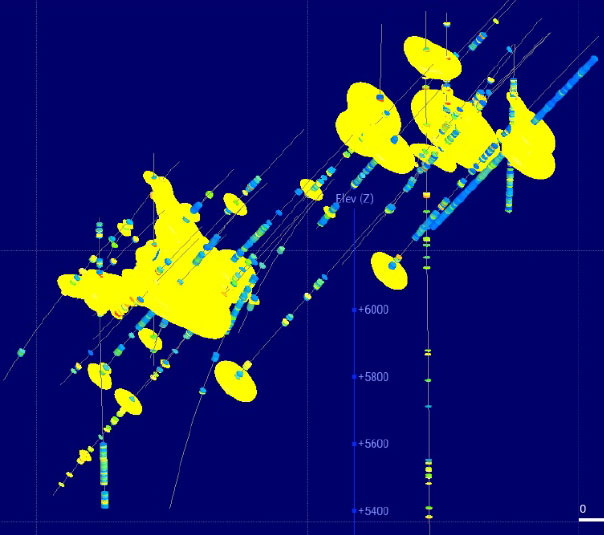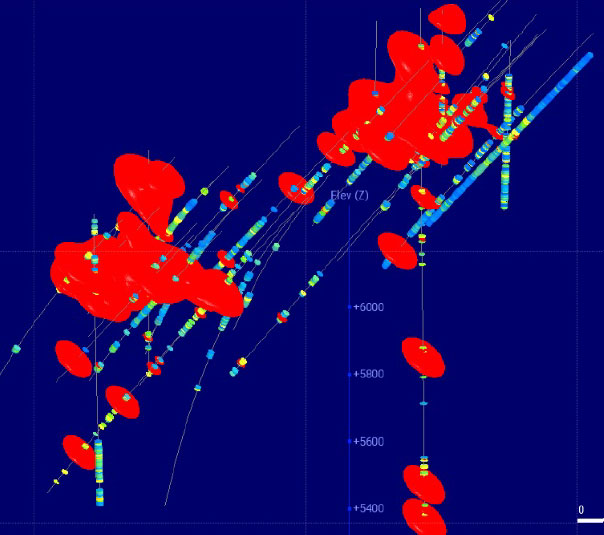Copper Mountain, Wyoming, USA
THE COPPER MOUNTAIN URANIUM PROJECT
LOCATED IN A PRIME URANIUM JURISDICTION
Wyoming hosts the largest-known uranium ore reserves in the United States and is now the focus of incoming investment.
- The state leads U.S. in uranium production, home to 5 operating uranium mines (all ISL).
- Wyoming accounts for 69% of all domestically mined uranium, strong potential for large-scale uranium discoveries.
- Strong support for uranium development from the Wyoming State government.
FAVOURABLE DISTRICT WITH ACCESS TO INFRASTRUCTURE
One of the largest uranium projects in Wyoming.
- 10k + acre land package with 7 historic deposits and 15 additional targets.
- 75% project interest earned under option agreement with Rush Rare Metals.
- Myriad the first to consolidate ownership of the Copper Mountain District in over 50 years.
- Bendix (BFEC, 1982) estimated that the total mineral endowment of the entire Copper Mountain District could be as much as 650 Mlbs eU3O8*.
*This estimate is historical in nature and does not represent current mineral resource, reserve or exploration target estimates under the category definitions provided by NI 43-101. It represents potential a mineral endowment that would require exploration work and drilling to verify. The key assumptions, parameters, and methods used to prepare the historical estimates are described in this document. There are no more recent estimates of this type. A qualified person has not done sufficient work to classify the historical estimate as current mineral resources or mineral reserves. Myriad and Rush are not treating the historical estimate as current mineral resources or mineral reserves. Also, while the Copper Mountain Project area contains all or most of each deposit referred to, some of the resources referred to may be located outside the current Copper Mountain Project area.
RESOURCE EXPANSION
Historic work provides a launchpad for rapid project advancement.

1950s-1960s
Legendary geologist and Myriad technical advisor Jim Davis discovers the Arrowhead Mine which, according to publicly available production records (United States Department of the Interior), produced ~500 klbs of uranium in the 1950’s and 1960’s.
1970s
Union Pacific drilled 2,000 boreholes discovering 7 deposits during the 70’s.
- They envisioned a conventional hub & spoke, 6-pit mine plan centered on the Canning deposit.
- They had designed a leach pad and had plans to commence mining in 1983, but dropped those plans in ~1980 after prices plummeted following Three Mile Island incident.
- Union Pacific estimated the potential of the 6-pit mine plan and additional targets (estimated and speculated) to be far higher.
Anaconda Copper drilled 19 boreholes into the Railroad Target area adjacent to Union Pacific’s Copper Mountain project.
- Intersected elevated mineralization at depth. Crucially tested for deeper mineralization associated with thrust faults.
1990s
Anaconda Uranium (no relation to Anaconda Copper) acquired all the historical data in the early 90’s and spent several years analyzing the data.
- They focused on an “Area of interest” at the Canning deposit.
- Two review reports (1991 and 1997) confirmed that Copper Mountain has substantial uranium mineralization with heap leach potential, and possibly an ISR option (not tested).
- Both recommended bulk sampling and testing as part of further work.
2006-2012
Neutron Energy & Strathmore both held parts of the Copper Mountain Project. Their ownership had separated the Canning deposit and most of the entire project.
Neutron Energy brought back geologist Jim Davis and re-evaluated all the historical data which was summarized in a 2008 technical report.
- Suggested the equivalent uranium grades used in the historic estimation were conservative and noted that fluorometric analyses suggested higher grades but were disregarded (Davis & Wilton, 2010).
- Recommended various programs targeting various styles of uranium mineralization.
MANY IMPORTANT GRANITE-RELATED DEPOSITS WORLDWIDE
Importance
- Historic drilling at Copper Mtn. mainly targeted granite-related mineralization (e.g. North Canning).
- Uranium mineralization hosted in faults and fractures.
- Similar deposits mined historically in Europe:
– Over 300,000 tU mined in France, Germany and Czech Republic 1 - Currently mined on large scale in China:
– 20 economical U deposits with recoverable reserves of 20,000 tU2
-
René, M. (2018). History of Uranium Mining 1 in Central Europe.
-
Zhong, F., Zhang, X., Wang, K., Wu, B., Liu, J., Pan, J. and Xia, F. (2023). Genesis of the Mianhuakeng granite-related uranium deposit, South China: Insights from cathodoluminescence imaging, fluid inclusions, and trace elements composition of hydrothermal quartz. Ore Geology Reviews 154 (2023) 105308.
COMPELLING GEOLOGY INCLUDING ISR POTENTIAL AT COPPER MTN.
Multiple Deposit Types
- Historic drilling mainly targeted granite-related mineralization (e.g. North Canning).
- Associated sedimentary mineralization (e.g. Arrowhead).
- Possibility of roll-front mineralization in Tertiary sediments (e.g. Cedar Ridge).
- Possibility of deeper thrust/unconformity-related mineralization (e.g. Railroad).
COPPER MOUNTAIN, WYOMING
LOOKING SOUTH FROM THE CANNING DEPOSIT AT COPPER MOUNTAIN, WYOMING
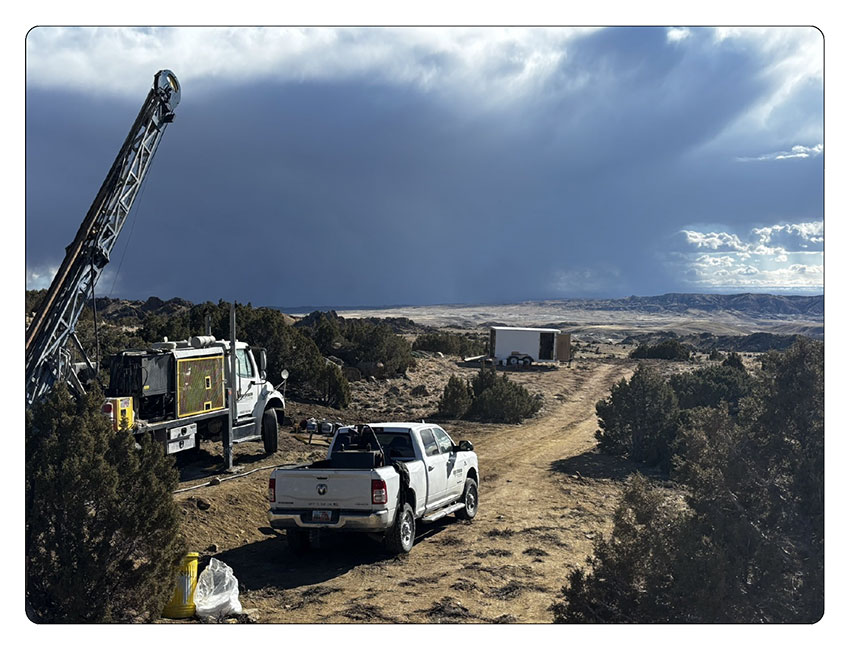
CANNING DEPOSIT DRILLING
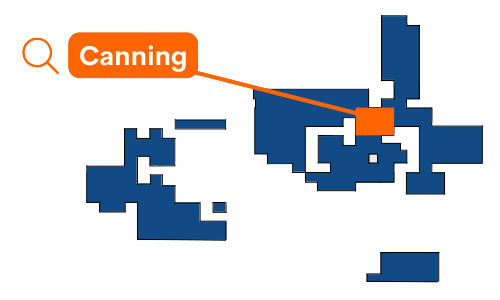
Historical Drilling
- ~820 holes were drilled in the Canning deposit by Union Pacific, generally to a maximum depths of around 180 m.
- Contains bulk of historic mineralization identified by Union Pacific.
- Priority area contains higher average grades than the overall mineralized area.
Myriad’s 2024 Drilling
- Focused on the priority target area, known to contain higher grades.
- 34 holes completed (RC and DD).
- Best grade interval: 5,337 ppm over 1.28 m from 68.7 m (CAN0004).
- Best GT interval: 4,361 ppm over 2.29 m from 80.9 m (CAN0006).
- See slides at the end for important details about the disclosure.
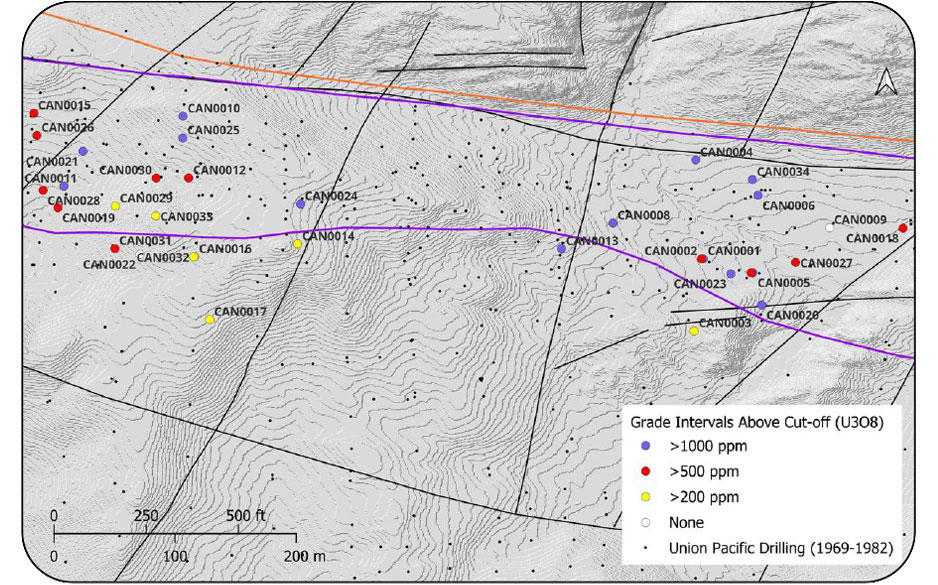
Fault Mineralising Model
Copper Mtn Uranium Project – Core Shed: Riverton, WY
ASSAYS
Assays from 34 holes have now been compared to the initial results from the spectral gamma probe, and the assays confirm much higher grades. In the 1970s, Union Pacific only used probe data to estimate resources and plan the mine.
- Union Pacific relied on DFN probe data, which was considered conservative.
- 1970s fluorometric assays indicated that DFN probe could be underestimating grades, but the results were disregarded in favor of DFN probe data.
- Reported ICP-MS assay results show chemical grades superior to spectral gamma probe equivalents, and gaps may also contain significant unreported uranium mineralization.
Assays across the 34 boreholes to date show the following relative to probe equivalent results:
- Assay grades 60% higher than eU O at 3 8 1,000 ppm cut-off.
- Assay grades 50% higher than eU3O8 at 500 ppm cut-off.
- Assay grades 20% higher than eU3O8 at 200 ppm cut-off.
- CAN0034 had a >250% improvement in grade from 344 ppm
- eU3O8 to 833 ppm U3O8 over 0.5 m at 454 m depth.
- See slides at the end for important details about the disclosure.
ASSAYS REVEAL HIGHER GRADES AND DEEPER MINERALIZATION
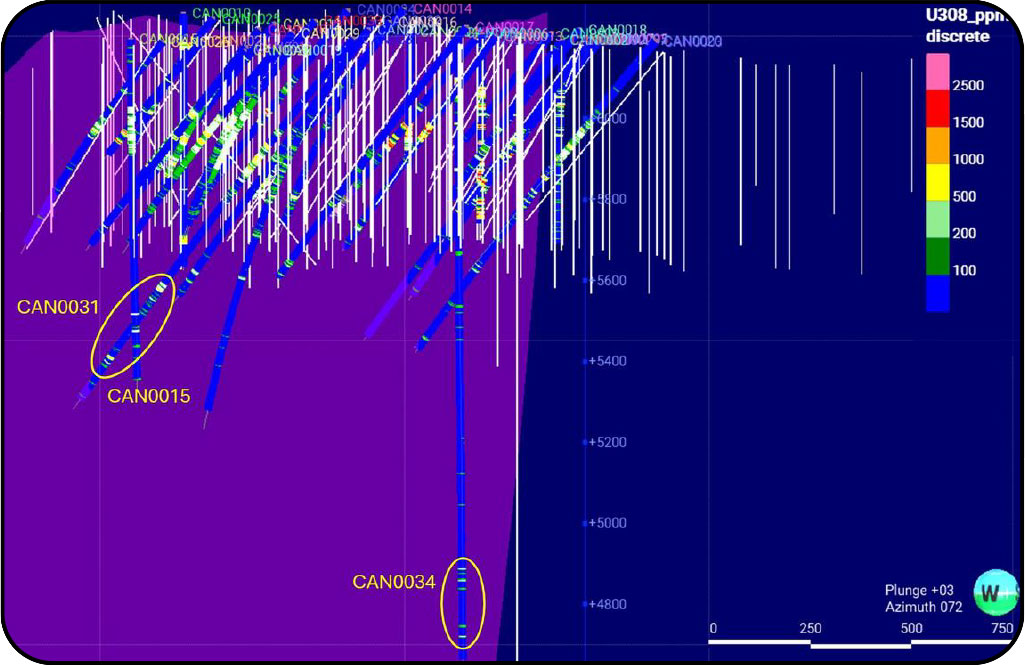
1970s to 2025: Assays Increase Shell Volumes and Avg Grade
Planning Model (Historic Data)
(Based on more data points)
Equivalent Uranium (Probe) – eU3O8 Model
(Based on less data points)
Assay Uranium (Laboratory) – U3O8 Model
(Based on less data points)


1970s: Canning Grade Shells
Modelled from historical cross-sections

34 New Boreholes at Canning
Modelled from gamma probe data (equivalent uranium)

Overlay: 1970's data + 2024 gamma probe

2025: Sample Chemical Assays
Modelled from assay data – Probe grades enhanced by up to 60%
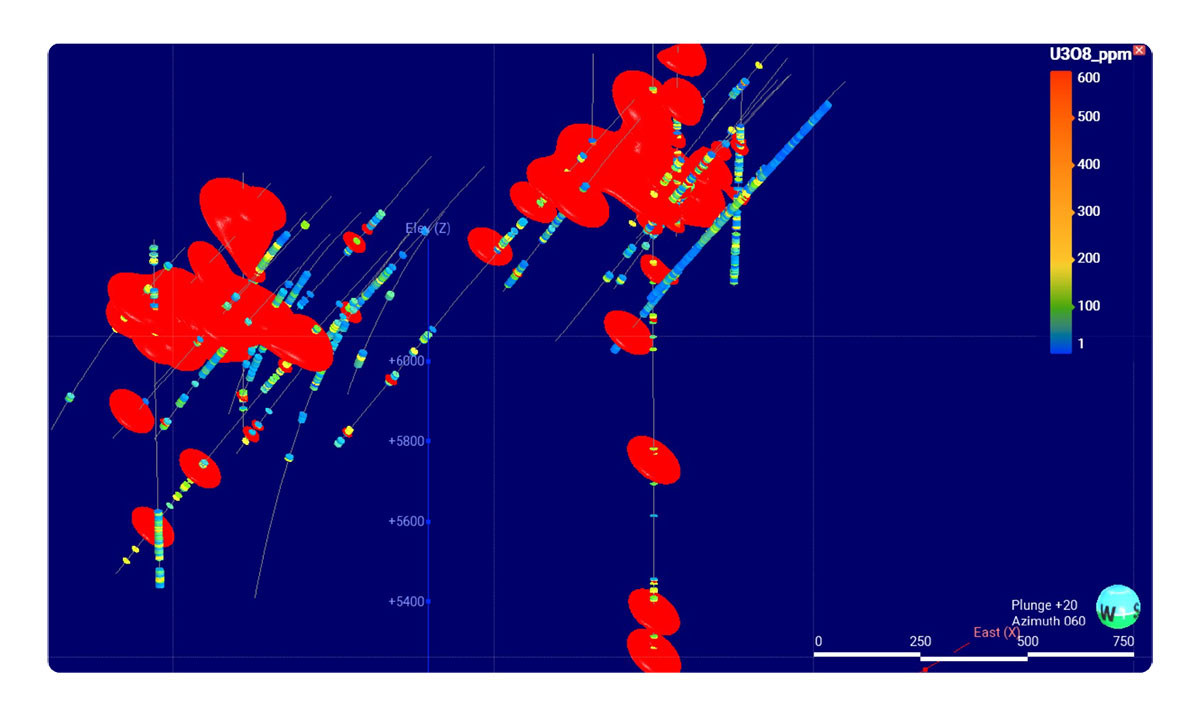
Overlay: 1970s Drilling + 2024 Probe + 2025 Assays
Combined models – more uranium after assays

PRIORITY TARGETS
PRIORITY EXPLORATION TARGETS GUIDED BY HISTORIC DATA

PRIORITY EXPLORATION TARGETS GUIDED BY HISTORIC DATA

These estimates are historical and not current under NI 43-101: refer to slides at the end of this presentation for important information about this disclosure.
COPPER MOUNTAIN PROGRESS
Consolidate and Acquire the Copper Mountain Project
- Myriad has earned a 75% interest in Copper Mountain by spending over $5.5 million on eligible expenditures under the property option agreement under with Rush Rare Metals.
- Myriad has almost doubled its land position to include the historically-defined deposits and targets in the district.
Acquire Historic Data
- Acquire data relating to the US$86 million in historic spend (2024$) at the project.
“Myriad Transformed as Data Trove Reveals Significant Historical Uranium Resources at Copper Mountain” – Oct 2023 news release.
Commence Myriad’s Maiden Drill Program
- Confirm historically reported mineralization with Fall 2024 maiden drill program.
- Focus on the Canning deposit which was the cornerstone of Union Pacific’s 6-pit mine plan.
Next Steps
- Report upcoming chemical assays from gap sampling; assimilate new uranium endowment estimates from Bendix (up to 656 Mlbs*).
- Drill at other targets around Copper Mountain to confirm the broader potential of the district.
- Continue testing deeper zones below historical 175m general maximum depth of drilling.




